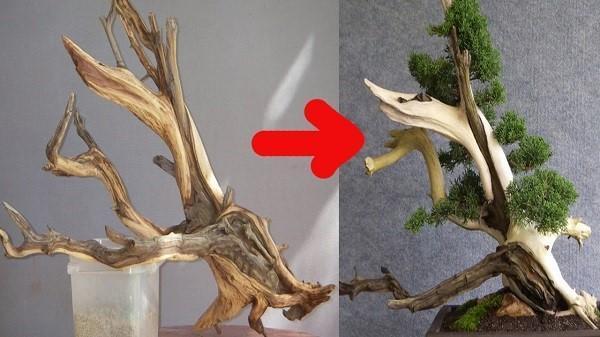Fake bonsai or how to make juniper tanuki
 The art of bonsai is admirable, and its masters can be considered real wizards and virtuosos. One of the most interesting and distinctive styles in this art is tanuki - making fake bonsai. We will talk about what it is and how to make it from juniper today.
The art of bonsai is admirable, and its masters can be considered real wizards and virtuosos. One of the most interesting and distinctive styles in this art is tanuki - making fake bonsai. We will talk about what it is and how to make it from juniper today.
Juniper for tanuki is the most suitable crop, because it is very flexible and tolerates "surgical intervention" well, that is, it continues to grow actively even if there are holes made for fastening in the stem.
Characteristics of tanuki
The tanuki technique consists of combining two different materials of plant origin, one of which is already dead, and the second is still alive. Simply put, a young tree is screwed to a support. It is served by an interesting form of driftwood - the more convolutions and bends on it, the more original and beautiful the result will be. Depressions are made in the snag, into which the living stem is embedded. As the trees grow, the attachments are removed, and a bonsai is formed from it according to general principles.
Translated from Japanese, tanuki means "badger" - an evil and cunning animal. This word is called what is not so in reality, that is, unreal.
Driftwood selection
An ordinary dry bitch will not work for creating tanuki, because bonsai must grow in the soil that is watered, and the moisture rots the wood. Based on this, the snag must be selected from very hard trees so that it is dense enough.
The shape of the future tanuki directly depends on the shape of the driftwood - the more twisting it is, the more beautiful and bizarre the bonsai will be.
Choice of capacity
The size of the pot depends on the stages of creation:
- at the first stage, while the juniper gains the required height and thickness of the trunk, a large pot will be needed so that the plant has enough space for growing roots and, accordingly, the ground part;
- at the second stage, when the tree acquires the necessary parameters, it will need to be transplanted into a flat bowl, in which bonsai is usually grown.
How to collect tanuki?
Having prepared everything you need, you can proceed directly to the assembly process:
- Drill 4 holes for the wire at the bottom of the container, close them with a net and secure it.
- Cut the lower end of the driftwood with a straight cut (for stability), drill holes on it, and screw the fastening rings into them.
- Make a fairly deep groove on the snag.
- Put the barrel in it, having previously cut off all the needles on it from the side of contact. The roots should remain close to the base.
- Fasten the trunk to the driftwood with screws.
- Pour some earth on the bottom and place a stone on it. Place the plant with the base on top and attach it with copper wire, passing it through the rings and holes at the bottom of the pot.
- Top up the soil.
Planted this way juniper should be watered and placed in partial shade for 10 days, then put in a well-lit place. After a month, you can carry out the first feeding. As the stem grows and thickens, the screws are gradually removed, and further bonsai formation is carried out. After 2-3 years, the juniper will be ready to be transplanted into a flat pot.